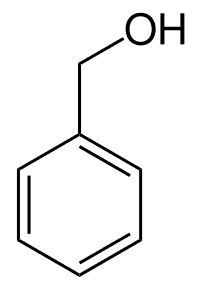Benzyl alcohol
Purpose
Benzyl alcohol can be used to increase membrane fluidity. It has been traditionally used as anaestheticum. Since membrane fluidity is central for temperature sensing, it has been used to modulate cold and heat sensing of animal and plant cells.
Mode of action
Benzyl alcohol is relatively lipophilic and therefore partitions from aequous solution into lipid membranes. Since it is neutral, it disrupts the electrostatic interactions of charged head moieties of membrane lipids. Therefore it increases the fluidity of the membrane. Side effects have not been reported so far.
Chemical properties
- CAS number 100-51-6
- MW 108
- synonyms: phenylmethanol, phenylcarbinol, E 1519 (since it is used in food industry as additive), BnOH
- a heavy liquid, moderately soluble in water (3.9 % v/v), well soluble in ethanol or oils (such as lineseed oil)
- not hazardous, it is even used as food additive due to its almond aroma, however, some people respond by allergies
- it has been classically used as anaestheticum
Active concentrations
- rat liver cells: a threshold of 10 mM of benzyl alcohol was needed to see increased membrane fluidity (Gordon et al. 1980), authors went up to 100 mM
- mammalian cancer cells: to see an effect on heat shock responses (Balogh et al. 2005) 5-50 mM of benzyl alcohol were used, significant effects were seen from 5 mM increasing linearly
- alfalfa cells: 5 mM were used to suppress cold sensing (Örvar et al. 2005)
- grapevine cells: treatment with 4 mM benzyl alcohol suppressed efficiently cold induced disassembly of microtubules (Wang and Nick 2017)
Work from our group using benzyl alcohol
134. Wang L, Nick P (2017) Cold sensing in grapevine - which signals are upstream of the microtubular “thermometer". Plant Cell Environment 40, 2844-2857 - pdf
References
Balogh G, Horváth1 I, Nagy E, Hoyk Z, Benkö S, Bensaude O, Vígh L (2005) The hyperfluidization of mammalian cell membranes acts as a signal to initiate the heat shock protein response. FEBS Journal 272, 6077–6086. pdf (in this paper, benzyl alcohol is used to change the temperature threshold for the induction of heat-shock proteins in mammalian cells)
Gordon LM, Sauerheber RD, Esgate JA, Dipple I, Robert I, Marchmont N, Houslay MD (1980) The Increase in Bilayer Fluidity of Rat Liver Plasma MembranesAchieved by the Local Anesthetic Benzyl Alcohol AfYects the Activity of Intrinsic Membrane Enzymes. J Biol Chemistry 255, 4519-4527. pdf (in this classical paper, the membrane fluidity effect is shown in rat liver membranes using biophysical parameters of a labelled probe)
Örvar BL, Sangwan V, Omann F, Dhindsa RS (2000) Early steps in cold sensing by plant cells: the role of actin cytoskeleton and membrane fluidity. Plant J 23, 785-794. pdf (this is one of the few plant papers, where benzyl alcohol has been used along with other drugs to modulate membrane fluidity and actin cytoskeleton in alfalfa cells, the effect of the drug has been tested using a polarisation based readout. Very good paper worth reading)

